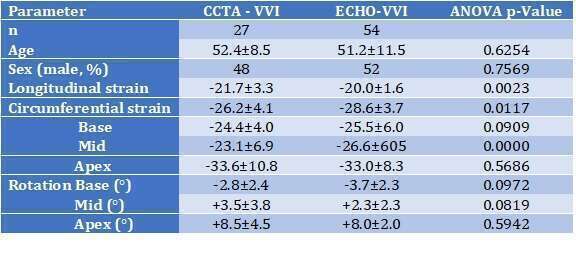
Application of Echocardiographic Feature Tracking Software on Cardiac CT Cine Clips – comparing Patients with Normal Coronary CT Angiography to Patients with Normal Strain Echocardiography
2Cardiovascular Institute, Poriya Medical Center, Israel
3Radilogy Institute, Poriya Medical Center, Israel
Introduction Cardiac computerized tomographic angiography (CCTA) is perceived as a tool for assessment of coronary vessels anatomy and narrowing, as well as for evaluation of great vessel structural anatomy. Multi-phasic volumes segmentation can only yield chamber global function. Feature tracking echocardiography has recently emerged as a tool for assessment of regional as well as global left ventricular function by assessment of DICOM images to report peak longitudinal and circumferential regional and global tissue strain, rotation, and timing of these events. The purpose of our study was to apply echocardiographic tissue strain imaging software on CCTA cine clips to validate its measurement against matched age and gender echocardiographic cohort.
Methods All CCTA studies were done on the Philips iCT 256 machine. Prospective coronary high energy reconstructions were done at 35% and 75% of cycle length. Post acquision reconstructions were done at 5% increments (20 per cycle) with the iDose protocol. Philips Intellispace ver. 8 was used to generate classic echocardiographic long and short views. Siemens Velocity Vector Imaging (VVI) software was applied on these cine image to generate strain and displacement results. Of 61 consecutive studies, 27 with normal function and no coronary disease were selected and compared to 54 age and gender normal echocardiographic studies.
Results In 60 cases (98%) CCTA segmentation yielded similar volumes and ejection fraction measurements as bi-Planar VVI (LVEDP r=0.83, y=1x+8ml, EF r=0.58, y=0.6+23%). Myocardial mechanics parameters generated were similar to one generated in normal echocardiography. One case could not be analyzed due to very irregular rhythm affecting reconstruction. See Table for CCTA to Echo Comparisons.
Conclusion Applying feature tracking software (VVI) to CCTA cine DICOM clips is feasible and generates similar myocardial mechanics parameters results to echocardiography derived measurements. Along with strains it correctly identifies the direction and extent of rotational displacement.
Powered by Eventact EMS